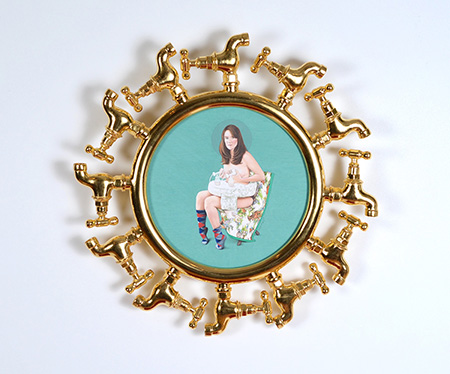
Continuing through October 29, 2022
Pakistani-American artist Humaira Abid extends her daring explorations of the exploitation and oppression of women in the developing world, here adding to her list of taboo subjects prevalent in Islamic countries. Before, as seen in her Bellevue Arts Museum survey (“Searching for Home,” 2017), Abid concentrated on the fate of women, parents, and children caught up in refugee crises. Her current work reiterates some of those images — shoes, swings, clothing, barbed wire — but introduces two heretofore intimately private activities, maternal breastfeeding and sperm-and-egg fertilization, sure to annoy and enrage the mullahs back home.
Much of what is remarkable and jolting about Abid’s work is the quiet, calm, determined construction of each sculpture or installation compared to its often outrageous subjects: carved pine, gilt wood, faintly colored drawings with sparing use of color. “Protest Signs” (2021), low-relief wall sculptures of wood, resemble throwaway corrugated cardboard with taunting slogans whose language takes their cues from Jenny Holzer and Barbara Kruger: “Fight Like a Girl,” “Blame Rapist Not Victim,” “Where is My Name?” and “Tolerating Racism is Racism.”
The use of language in these works is the least effective of Abid’s strategies. They are overshadowed by the four children’s swings in the center of the front gallery, all suspended from the ceiling. Each swing seat has an intricately painted garden scene with happy children that is reminiscent of Persian or Mughal miniatures. Beneath each swing seat, on a white disk, are various fragments of wood chips, wooden shoes, or slippers. The series, titled “This World is Beautiful, and Dangerous, Too” (2017-2022), emphasizes children as victims of internecine conflict arising out of extremist and fundamentalist religious practice.
While wooden wall sculptures feature girls’ dresses in the “Folded Stories” series, all packed for the suitcase and ready to leave in a hurry, a more complicated sculpture explores Abid’s own identity in “Self-Portrait 3” (2022). Here, the artist’s head is submerged in a carved box containing rising water, all surrounded by outer layers of gilded frames, simultaneously confining and treasuring the contents. Familiar from Bellevue, “Letters To My Brother, My Molester and to My Mother” (2020) remains one of Abid’s most powerful and troubling artworks. Based on a friend’s experiences, Abid has meticulously reproduced in wood and original handwritten letters the accusatory epistles sent to the friend’s relatives for their acceptance of the incestuous rape. This alone could lead to court actions and religious fatwas were the work exhibited openly in Pakistan; Abid’s safety involves her exile in the U.S. and her increasingly international profile as a significant figure in contemporary protest art.
Leaving Pakistan and its forlorn problems surrounding the rights of women, Abid takes us to Saudi Arabia, which she pillories in her “Tempting Eyes” series (2021). Crown Prince Mohammed bin Salman al Saud may have allowed Saudi women to drive cars, but several have been imprisoned for their progressive views beyond the vehicular. Abid ingeniously uses black-stained, carved-wood, rear-view mirrors mounted on the wall, replacing the mirror glass with paintings of the women’s eyes peeking through veil-holes as they sit behind the steering wheel. Related ornaments are suspended from the mirror like trinkets in a real car, but in this case she uses emblems in Arabic script. The title, “Tempting Eyes XVI (with ornament)” (2021), is an ironic put-down of the purported sexual temptations Arab women are guilty of should they be given greater freedoms, like driving to the supermarket or beauty salon. This is particularly painful in such a wealthy country with so many younger women educated in the West at prestigious institutions. Upon their return home they are routinely subjugated to gilded cages. Maybe Abid could next address the underclass of working women in Saudi Arabia, primarily domestic workers from developing nations who are often subject to violence and rape by their arrogant employers.
The unusual profile of a breast pump first appeared in a gouache drawing, “Aspect of Motherhood” (2011). A decade later, “Woman with Breast Pump” (2022) highlights a circular, gilded frame surrounding a naked woman employing two breast pumps while staring at the viewer. Gilded spigots line the frame. Abid continues to push the limits of outdated propriety, nudging and shoving women’s issues to the forefront of contemporary art.
